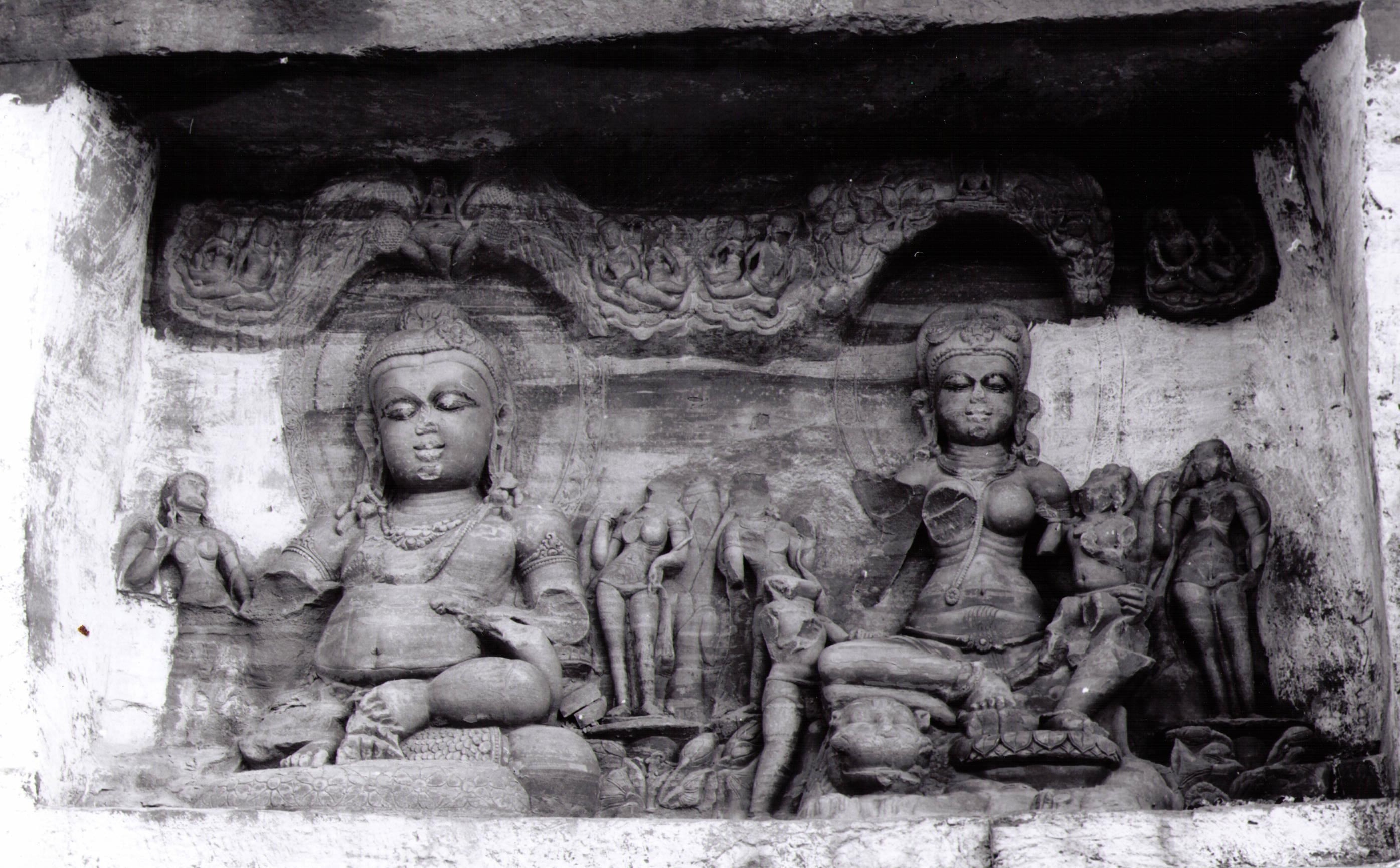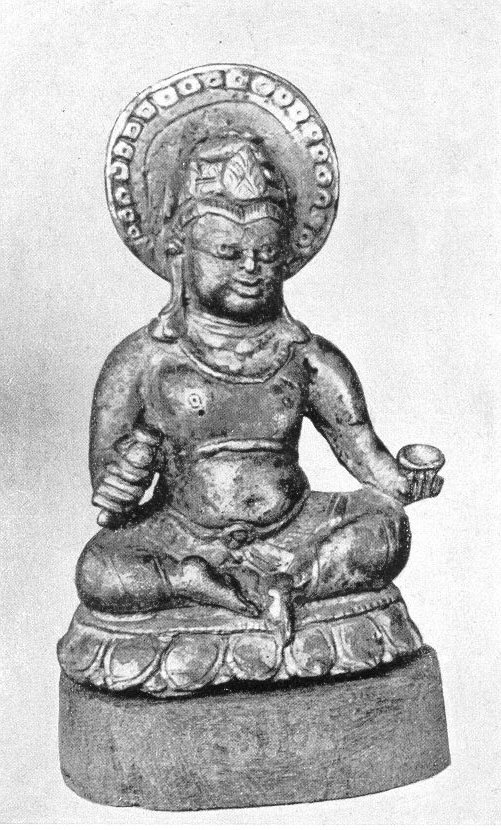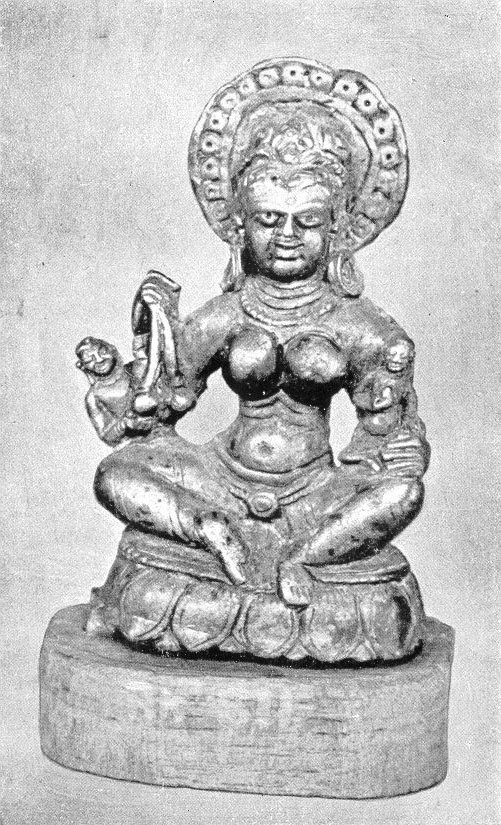
The essay was published in Berliner Indologische Studien No. 13/14. 2000, pp. 273-337.
§ 10. List of Figures and Notes (II)
 |
Fig. 6 |
§ 3. Kubera-and-Ambikā. Gwalior Fort. Rock-cut. A.D. 700-800. - This is the only great multi-figured relief of K-and-A in Northern India, and perhaps the only case where K-and-A appear together but not below a dominating Jina. We have published the relief already twice (JID: figs. 18-18A; Bruhn Gw: fig. 152). Below Kubera, the artist showed a big jar lying on the ground and oozing coins. - Photo: Günter Heil (Berlin). |
 |
Fig. 7 |
 |
Fig. 8 |
Figs. 7-8. § 3. Kubera and Ambikā; separated from the socle of a Jina image (Shah Ak: figs. 38a, 38b; Jina: fig. 39). Bronze. U.P. Shah: c. A.D. 700-725. - Ambikā is shown with a second child (motif of the standing boy), but the sex of the child is not indicated. Kubera is irregular (§ 3): he holds a cup of wine in his left hand and a compact lotus in his right hand. The bhāmaṇḍala.s are simple, and this may indicate that the image is earlier than the images with “flamboyant“ bhāmaṇḍala.s (such as Shah Ak: figs. 23a-23b; “middle of 7th cent.“). - Photo: U.P. Shah, Akota Bronzes, figs. 38a-38b. |
 |
Fig. 9 |
 |
Fig. 10 |
Figs. 9-10. § 3. Kubera (fig. 9) and Indra (fig. 10) in niches on the exterior of the Mālādevī Temple, Gyaraspur. A.D. 850-900. Fig. 9 published Trivedi Pr: fig. 176. - The two images appear in the two large niches which flank one of the balconies of the north wall (Kubera to the right, Indra to the left). Both gods are two-armed, have a slender build (standard build) and are represented with a crown. Kubera (standing) grasps with his left hand an enormous cornucopiae resting on two small jars; in his right hand he holds a cup of wine or a fruit. He is accompanied by a ram. K. Deva observes: “The god [Kubera] is flanked on the proper right by a standing couple [?] and on the left by a male caurī-bearer“ (Deva Mā: 264). Refer also to the description given by R.N. Misra (Misra Ya: 71). Indra is seated on an elephant with his right foot resting on a jar (derived from the Kubera image?). In Indra's left hand, K. Deva noticed traces of a vajra (Deva Mā: 264-265). As a dikpāla, Kubera is mythologically and iconographically associated with the North, while Indra is associated with the East. Indra and Kubera are the only male figures on the exterior (ignoring one figure in smaller size) of the temple. - The Mālādevī Temple has Jina figures almost exclusively in its interior (especially the Jinas on the architrave: EITA II.2. Plates: pl. 111). As mentioned in § 2, there are no miniature Jinas above the deities in the niches on its exterior. Refer for further iconographic details of Kubera and Indra to Deva Mā: 264-265 (niche XIV “on the north projection of the antarāla“, niche XVI “on the north projection of the maṇḍapa“). A systematic documentation of the iconography of the Mālādevī Temple does not exist. The general impression is that the iconographic programme includes numerous unidentified female figures which can only be connected in a general manner with the vast pantheon of medieval goddesses (Jaina mahāvidyās, yoginīs, etc.). Kubera is sometimes Hindu and sometimes Jaina (§ 3), and his appearance on the Mālādevī temple is not unexpected. - Refer for the Mālādevī Temple to EITA II.2. Plates: pls. 98-113, and to Trivedi Pr: pls. 167-177; for the plan of the temple to Trivedi Pr: 156, and to EITA II.2. Text: 49. - Author's photos, Bruhn Ar: 2894 and 2897. |
 Prof. Dr. Klaus Bruhn
Prof. Dr. Klaus Bruhn